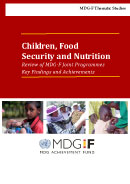

Children, Food Security and Nutrition
Over the past 20 years, the number of stunted children under the age of five has fallen by 88 million. But one quarter of all children are still stunted, and poor nutrition causes 3.1 million child deaths each year.
With a total allocation of US$131.9 million, this was our largest area of intervention, representing almost 20% of the MDG-F’s work. Initiatives ranged from providing low cost nutritional packages to engaging with pregnant and lactating mothers to promote breastfeeding and ensure they are healthy and aware of key nutrition issues. Promoting food security and advocating for mainstreaming children’s right to food into national plans and policies were also keys element in our fight against under nutrition.
RESULTS OF OUR WORK:
- 1.6 million children and 800,000 mothers have better nutrition.
- 1.2 million mothers and children benefitted from breastfeeding programmes and policies.
- Almost 83,000 health workers and 6,500 health centers, and more than 2,500 schools and 8,000 local and national institutions partnered to fight malnutriiton.
Click here for a complete report of the indicators and results achieved by the MDG-F’s 24 joint programmes on Children, Food Security and Nutrition.
Success Stories

Analysis of key findings and achievements
This report captures the main achievements and experiences of the MDG-F’s programmes in this thematic window and presents their impact on the lives of communities across five regions. Prepared by an independent expert, the study is based on extensive desk reviews, interviews with selected joint programmes, and a thorough analysis and synthesis of inputs and contributions.
| Download Summary | Download Full Report |
|
Joint Programme Title
Country
MDG-F Programme Area
|

